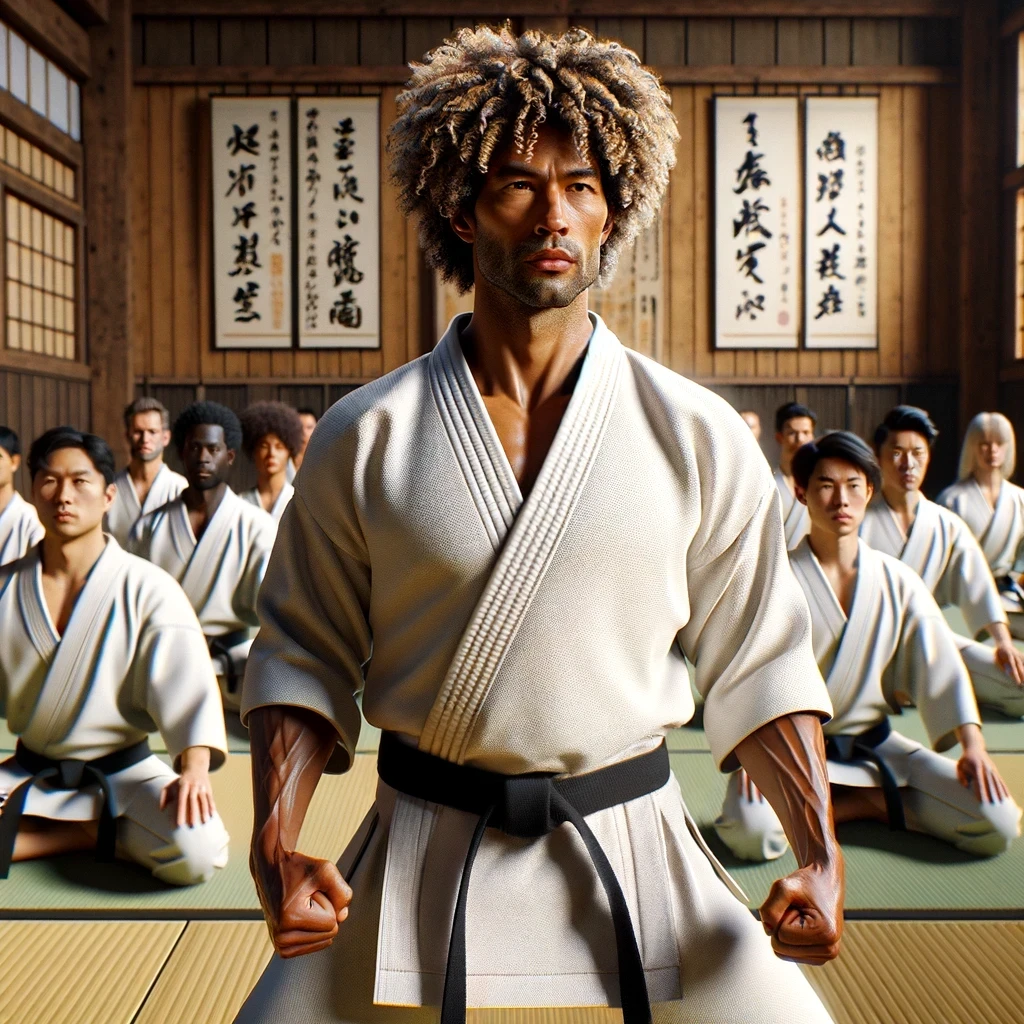Ōssu, Ōss, Ōssss! 押忍: “The Ō word.” Unveiling the Essence of “Ōss”: From Karate Dojo to Linguistic Exploration…
All Gojuryu Network (www.gojuryu.network) & SKSV (Gojuryu.net) cross-post By Johnpaul Williams – April 1, 2024.
The Ōssu Conundrum: Navigating Nuances of a Nonconventional Japanese Martial Arts Vocabulary In the world of traditional Karate, few words are as ubiquitous and yet as misunderstood as “Ōsu” (押忍). The following article was originally penned for the Gojuryu.net (the Gojuryu Network) in a March 2003 commentary, this article delves into the complexities and cultural nuances of a term that has transcended its martial origins to become a global phenomenon. The subject has since been revisited by many personalities in both Japan and around the world having varied valid interpretations. In this exposé, we embark on a journey to explore the multifaceted nature of “Ōss,” its variations and links to the enigmatic concept of “Oshi Shinobu 押し忍ぶ,” while educating ourselves on use and meaning. Ōssu, Ōss, Ōssss! 押忍: To push and persevere is an over-used four (4) letter word that should be utilized thoughtfully. The Japanese term “Ōss” (押忍), oftentimes written as “Ōssu” (押っ忍), is derived from multiple sources, having an intrinsic connection to “Oshi Shinobu 押し忍ぶ,” and military hierarchy. In the world of martial arts, certain terms transcend their linguistic origins to become symbols of respect, camaraderie, and discipline. This seemingly simple word carries a rich history, spanning cultural nuances and martial philosophies. The Origin of “Ōss.”
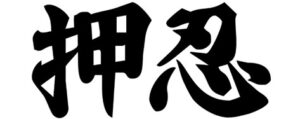
Oss Kanji
“Ōss,” pronounced like “Ōssu” or “Ōsu” (with a prolonged ‘o’ sound, written as “おっす”), is a term deeply ingrained in the lexicon of Karate practitioners. However, its origin remains a subject of debate and speculation. Some believe it to be a contraction of two Japanese words: “Onegai shimasu お願いします”, which loosely translates to “Please” or “I humbly request.” This interpretation aligns with the martial arts ethos of respect and humility. The exact source of “Ōss” (or “Ōssu”) in the context of martial arts, particularly in Karate, is a subject of debate and speculation. The most common origins are:
- Onegai shimasu お願いします: Some believe that “Ōssu” is a contraction or abbreviation of the Japanese phrase “Onegai shimasu お願いします”, which roughly translates to “Please” or “I humbly request.” In this interpretation, “Ōss” is used as a greeting and a sign of respect to instructors and fellow practitioners, embodying the martial arts ethos of humility and respect.
- Oshi Shinobu 押し忍ぶ: Another theory suggests that “Ōss” may be related to the concept of “Oshi Shinobu 押し忍ぶ,” which can be loosely translated as “to persevere” or “to endure with determination.” This interpretation emphasizes the mental fortitude and determination required in martial arts training. Fitting if term “Ōsu” is derived from the Japanese verb “osu,” which means “to push,” and the noun “shinobu,” which signifies “endurance” or “perseverance.”
Ōss and Oshi Shinobu 押し忍ぶ: A Philosophical Perspective The link between “Ōss” and “Oshi Shinobu” offers an intriguing perspective. “Oshi Shinobu” implies not only physical endurance but also mental and emotional resilience. In this sense, “Ōss” could be seen as a condensed form of this concept, encapsulating the spirit of persevering through challenges, both on and off the dojo floor. Dr. Mizutani Osamu, a highly regarded language and linguistics professor at the University of Nagoya, concluded that ‘Ōssu’ is ‘likely’ a contraction of the more formal expression “Ohayo gozaimasu、” a very polite way of saying “good morning.” Dr. Mizutani postulates that “Ōsu!” is a rough masculine expression used in masculine environments. The terminology “Ōssu” was initiated over one hundred of years ago, being disseminated by the Imperial Japanese Navy (Dai Nippon Teikoku Kaigun 大日本帝国海軍) and further popularized in the martial arts world by Kyokushinkai 極真会 and its founder, Masutatsu Ōyama 大山倍達, with his seminal work “The spirit of Ōssu” (Ōssu no Seishin 押忍の精神). Ōssu押忍 has since spread through most of the traditional karate world and is generally accepted when not overused. Today when properly exercised, Ōssu押忍 is an interjection akin to “yes sir.”
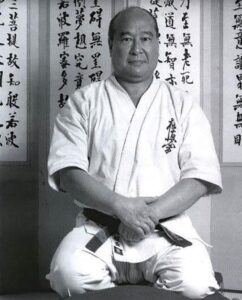 Mas Oyama kneeling in Seiza |
 Kanji for Ossu no Seishin by Mas Oyama |
|
押忍の精神 (Ōssu no Seishin) の大山倍達 Ōssu no Seishin “The spirit of Ōssu” by Ōyama (Mas) Masutatsu 大山倍達 |
|
The Karate Connection. In Karate dojos worldwide, “Ōss” serves various purposes, creating a unique linguistic environment: Greeting: In many martial arts dojos, “Ōss” is used as a greeting. When entering the dojo or encountering fellow practitioners, it’s common to say “Ōss” as a sign of respect and acknowledgment. It’s a way of saying, “Hello,” while also showing respect for your training partners and instructors.
- Acknowledgment: During training or when receiving instructions from an instructor, responding with “Ōss” is a way of acknowledging that you’ve understood and are ready to follow the guidance or instruction. It’s a form of showing respect to the teacher’s knowledge and authority.
- Unity and Camaraderie: When a group of martial artists comes together, especially before or after a training session, saying “Ōss” collectively can foster a sense of unity and camaraderie. It’s a way of emphasizing the shared commitment to martial arts principles and goals.
- Motivation: Some practitioners use “Ōss” as a form of self-motivation. It serves as a reminder to maintain focus, determination, and perseverance during training or challenging situations. It embodies the spirit of never giving up and pushing through difficulties.
- Parting: “Ōss” can also be used when leaving the dojo or parting ways with fellow practitioners. It’s a way of saying goodbye while maintaining the respectful and disciplined atmosphere of the martial arts environment.
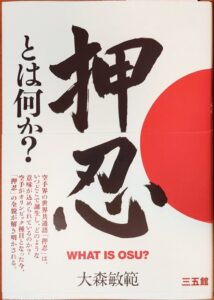 What is Osu – book cover |
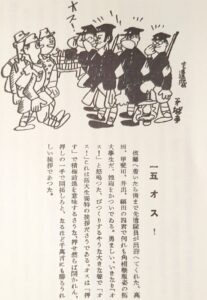 Osu Manga |
| “押忍 What is Ōsu” by Ōmori Toshinori 大森敏範. 200 pages. | 1939 Construction Labor Service Corp Manga Local Report “15 Ōsu” describes ‘Ōsu’ as: positive progress. |
| In “押忍 What is Ōsu、” Ōmori Toshinori 大森敏範 discusses (in depth) several origins of “Ōsu押” including Budō 武道, Jūdō 柔道, Karate-dō 空手道, military, historic adaptations and slang. | |
The Overuse of Ōsu: A Cautionary Tale The overuse of “Ōsu” can lead to a dilution of its meaning. In some Dōjō, it becomes a catch-all response for everything from greetings to affirmations. This indiscriminate usage can detract from the term’s original intent, transforming it into a mere filler word devoid of its intended respect and significance. The Usage of Ōsu: A Personal Anecdote Imagine walking into a friend’s Dōjō (道場), greeted by a chorus of “Ōsu” from his students. This scenario highlights the term’s role as a respectful acknowledgment, akin to “yes, sir.” However, the frequency of its use can vary significantly between different styles and schools of Karate. For instance, in a Shitō-Ryū (糸東流) Dōjō, you might notice a more restrained application of “Ōsu,” reflecting a nuanced understanding of its appropriate context. When is it acceptable to use “The Ō word”? Like any four (4) letter word, “The Ō word” should be used sparingly and only under unique circumstances. The ‘quasi-acceptable’ time to use ‘The Ō word’ is in acknowledgement of mutual respect or affirmation. Ōssu押忍 was described by Tasaki Shūji 田崎修司
(Founder of Gōjū-Ryū Karate-Dō Seiwakai 剛柔流空手道誠和会)
– “It is an important Japanese Value. Ōsu means ‘Endure and suppress yourself、’
– It should not be used frivolously.”
Others too, trace the roots of “Ōssu押忍” to “Oshi Shinobu 押し忍ぶ”, a phrase suggesting “to persevere” or “to endure with determination.” This connection adds a layer of resilience to the word, emphasizing the mental fortitude required in martial arts training. In a culture where many are short on time when passing, Ōssu押忍 is acceptable in pro-masculine context as a verbal salutation during athletic activities or those participating in pro-masculine activities (For example: Joggers in passing or, boxers at the gym, karateka displaying respect). Basically “Ōssu押忍” is a contagious ‘Machismo’ vernacular.
Ōssu is considered impolite in general Japanese language outside of dōjō 道場 or military. Especially directed to your seniors, it can possibly be taken or notated as
‘I don’t have the time to address your correctly.’
Because of this, I offer a suggestion, when in Japan, follow the lead of the native Japanese there to help you.
Fujisawa Orlando 寛 – Okinawa Shōrin-Ryū 沖縄 松林流 Brazil
Navigating the Use of Ōsu in Japan In Japan, the use of “Ōssu” is generally reserved for specific contexts, such as within certain Karate Dōjō or among male athletes. It is considered impolite and overly casual in many other settings, particularly when addressing seniors or in formal situations. Understanding this cultural nuance is crucial for foreign practitioners visiting Japan. Ōssu in Okinawa Ōssu 押忍in Okinawa has arguably been absent amongst many circles of Budō 武道 until only recently. From a historical point of view, in the 1940’s mainland Japanese military members stationed or passing through the Islands of Okinawa hadn’t had the best of reputations in regards to their relationship with inhabitants or natives of Okinawa and, the Imperial Japanese Navy used the terminology “Ōssu 押忍” regularly. This, magnified by the documented mistreatment of native Okinawans by the mainland Japanese military members left a generational animosity for the use of the term. This animosity, although now limited, still exists in many Okinawa Dōjō 道場 and much of the Okinawa prefecture today. The Global Perspective: Ōssu Outside Japan 日本. Internationally, “Ōssu 押忍” has become a symbol of spirit and does build camaraderie and within Karate Dōjō 空手道場, often used to foster a sense of unity and respect among practitioners. We have seen and heard championship national Kata 形 teams shout the sharpest “Ōssu 押忍” before the announcement of their Kata. As a universal expression of commitment and training “Ōssu 押忍” has become part of many ‘traditional’ Dōjō 道場 outside of Japan and will continue to do so. Today, many Japanese Sensei 先生 promote the use of “Ōssu 押忍” in classes and its use is becoming an engrained behavior. While the use of Ōssu, may be more liberal outside of Japan, understanding its roots and significance can enhance its meaningful application in a global context. When Is It Appropriate to Use Ōsu? “Ōsu” should be used judiciously, primarily as a sign of respect or acknowledgment in a martial arts setting. It is most fitting during training sessions, competitions, or when acknowledging a well-executed technique however, its use should be limited to avoid diluting the impact of the meaning. The Verdict on Ōsu: Use with Discretion In conclusion, “Ōssu” transcends its linguistic simplicity to embody the core values of respect, discipline, and perseverance within the world of martial arts, that are central to Karate. While its use has evolved and spread globally, maintaining an awareness of its cultural and historical significance is essential for preserving its integrity. Whether it originates from “Onegai shimasu お願いします” or finds its roots in “Oshi Shinobu 押し忍ぶ,” “Ōssu” serves as a powerful reminder of the mental and physical fortitude required on the path of martial arts having adapted to contemporary contexts while preserving the underlying philosophy. As with any aspect of traditional martial arts, understanding and respecting the context is key to its proper application.

